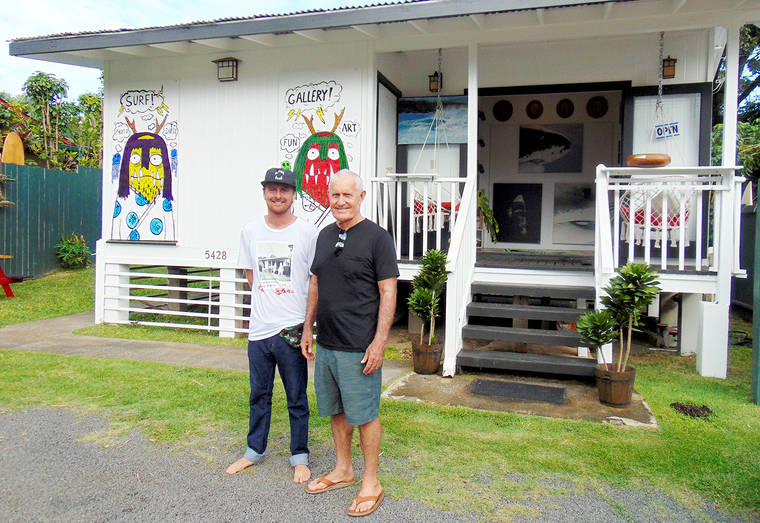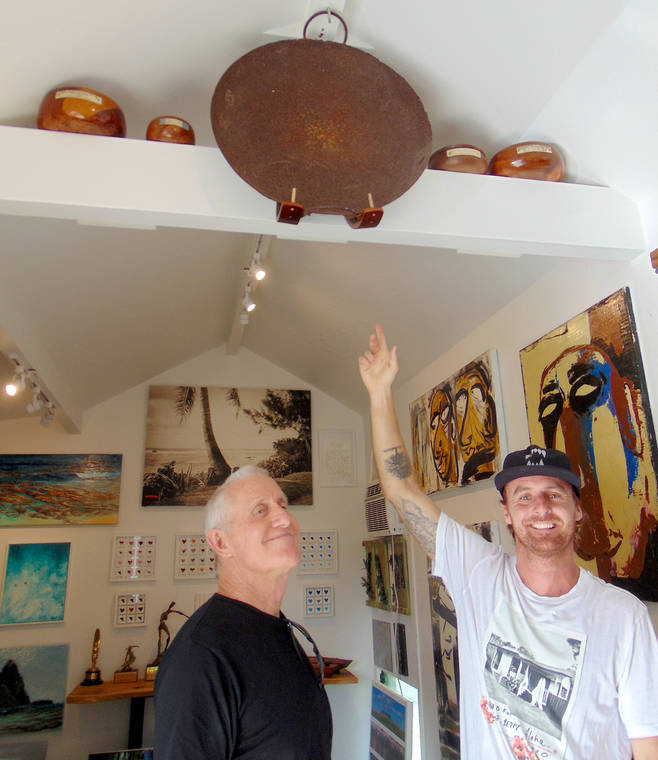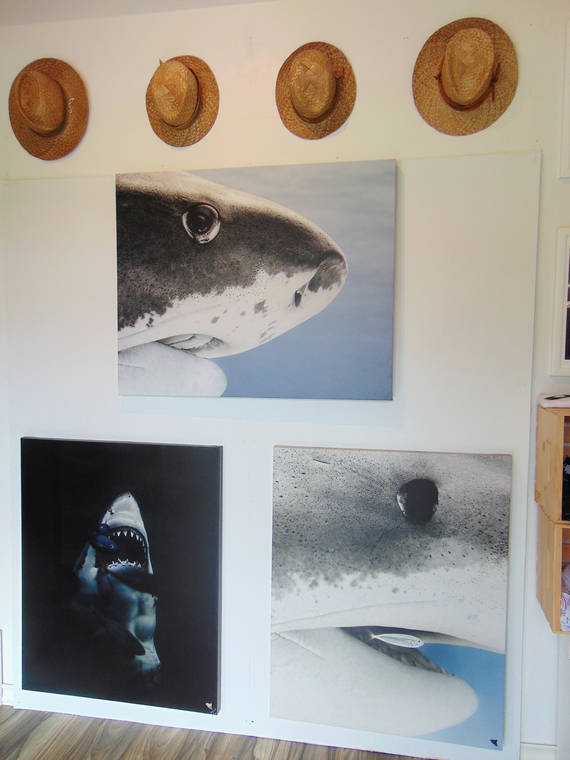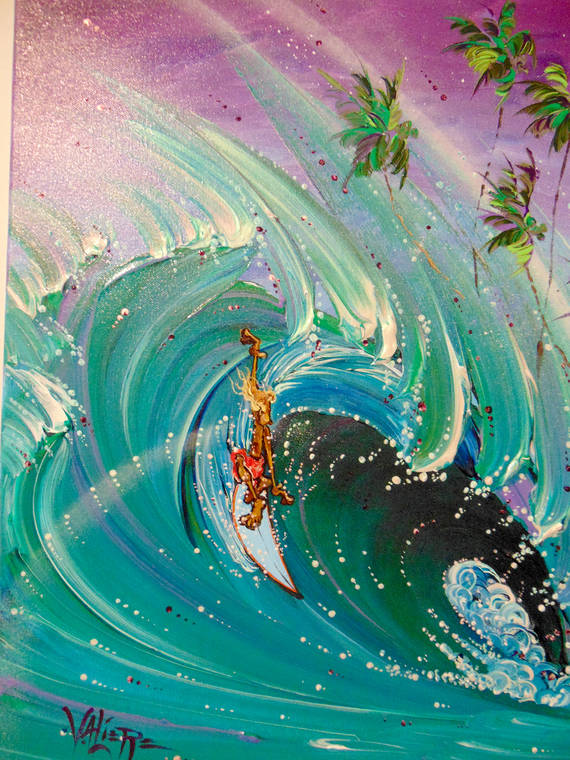After getting a tour of ‘Ohanalei gallery with owner Ryan Hakman, I soon learned that he is not only a creative and forward-thinking artist and surfer, but he also knows how to make history come alive through art.
To know how it all began is always an important part of the puzzle of understanding how things are today, and how they came to be. But often a big part of the missing element of sharing history with others is tying it into the present in a way that is tangible, and significant to the local community.
Hakman achieves this through his storytelling abilities as well as the artwork on the walls of ‘Ohanalei gallery, which opened Nov. 1.
The piece of history he shared with me started with a wok and the man who used it to feed his family and the community. A photograph on canvas depicts Bobo Hamyoung cooking with a wok next to the “Andy Irons” tree at Pine Trees beach about six years ago.
“This photo is from before Bobo passed away,” Hakman said. “He’s cooking, he’s always cooked in a wok, here he’s cooking chicken hekka. He shared a lot of history and told me stories of him growing up in Hanalei and how it was. He shared this with me about how Blackpot got its name.”
“Basically his family would catch all the fish down at the pier and they would trade the fish with the Chings for produce. They would use these cast iron woks when cooking at the beach and they would turn black after a while from cooking, and that’s how the beach got its name, Black Pot.”
Hamyoung’s “Black Pot” wok hangs in the rafters, displayed in a place of honor near a trophy of Hakman’s from a Pine Trees surf contest.
Closeby the photograph of Bobo Hamyoung is Lynne Hamyoung’s rare woven lauhala traditional Hawaii-style hats, called papalelauhala hats.
“She’s a master weaver from the Big Island and we’re real fortunate to have some of her hats here,” Hakman. “Once those are gone, there probably won’t be any more.”
A photograph on canvas in the gallery captures an iconic image of a young, 12-year-old Jeff Hakman, Ryan Hakman’s father, putting wax on his board before paddling out at Sunset Beach on Oahu for the first time.
“It was a real challenge, back in those days in the late 50s early 60s there weren’t a lot of young little guys who surfed Sunset Beach,” Jeff Hakman said. “There was this myth of it being dangerous and being reserved for more established surfers. It was a challenge for me but I started surfing it when I was 12 years old and became very good at it, hence the name Mr. Sunset.”
Jeff Hakman founded Quiksilver America with Bob McKnight in 1976 and then Quiksilver Europe with Harry Hodge, Brigitte Darrigrand and John Winship. Currently, he is the marketing director for NaPali SA (Quiksilver) in France. In 2009 Hakman was welcomed into the Surfers’ Hall of Fame in Huntington Beach, Calif.
Hakman won his first contest at Sunset Beach when he was 17 years old at the Duke Kahanamoku contest in 1965, paving the way for his career as a professional surfer and beyond, and after that the rest was history.
Below the photograph at Sunset are trophies of Jeff Hakman’s from two contests of which happened for the first time when he won his trophies, including the Duke Kahanamoku contest in 1965 and the Pipeline Masters in 1971. Hakman added that he was also the first foreigner to win at the Bells Beach Contest in 1976 in Australia.
Since the gallery opened, Jeff Hakman fills in at the gallery whenever his son needs help.
Hand silkscreened shirts hang nearby the front door. Ryan Hakman plans to rotate the product regularly so there are always fresh designs available for purchase. One of his shirt designs shows the photograph of his father when he was a kid at Sunset Beach.
Hakman’s own work, besides the T-shirts he makes, include work made out of resin from old surfboards. Resin collects on the floor of a shaper’s workshop and over time, creates layers of color. Hakman describes each boldly colored layer —from bright neons to deep blues, greens, and reds — as being created from a particular surfboard.
With the use of molds any shape can be made from pieces of resin from a shaper’s workshop, including his multi-colored shark teeth, which Hakman features in the gallery with other resin-design art of his.
Hakman credits well-known shark enthusiast and photographer Mike Coots with inspiring him to create his shark tooth resin work. Coots even has some daring photographs on canvas of sharks featured in the gallery.
Other artists in the surf gallery include Steven Valiere, father of pro surfer Evan Valiere, who is known for his bold, colorful paintings of big waves and daring wave riders.
Work by Patty Irons work can be viewed there as well, like her vibrant cover art for the surf film “The Innermost Limits of Pure Fun.” Both Valiere and Irons’ work embody the fun and lively essence and feeling behind surf art, but in two different but no less impressive ways.
There’s also works included featuring painted bright, tropical flowers and dining scenes by Camille Fontaine, painted cartoon style creatures by Bryce Baker, ocean art in resin by Cheyne Tasic, and ocean and seascape paintings by Maxine Longoria, and patches created by Brelan Sugahara.
The variety of work in a small space really shows how lively and brilliant surf art can be, which often strays from the norm, but in a good way.
In the future, Hakman expects to host monthly events at the gallery, and will be rotating featured artwork.
Opening the doors of ‘Ohanalei was something the surf artisan has long wanted to do.
“It’s always been a dream of mine, it’s taken what?” he said. “Six, seven years maybe? But now it’s finally happening.”
Ryan Hakman says of his mission behind ‘Ohanalei: “I’m trying to really showcase art and history, that’s what I am interested in. That’s what I live for every day. People enjoy the original story. Something that’s real. I do, anyway.”









Where is Ohanalei Gallery located, please?
The gallery is located in Hanalei across the street from Hanalei School.
Would be nice if the article told where it’s located in Hanalei.